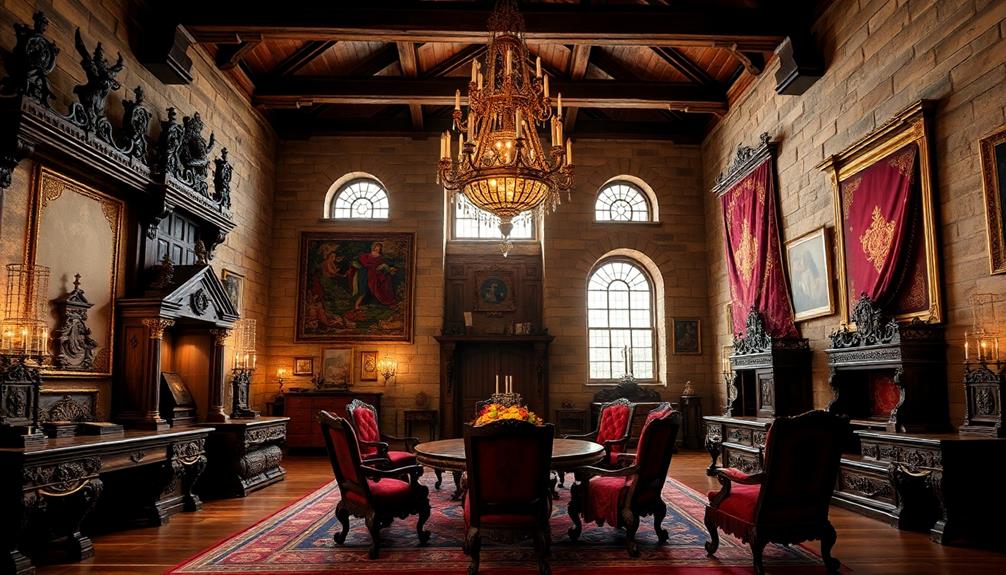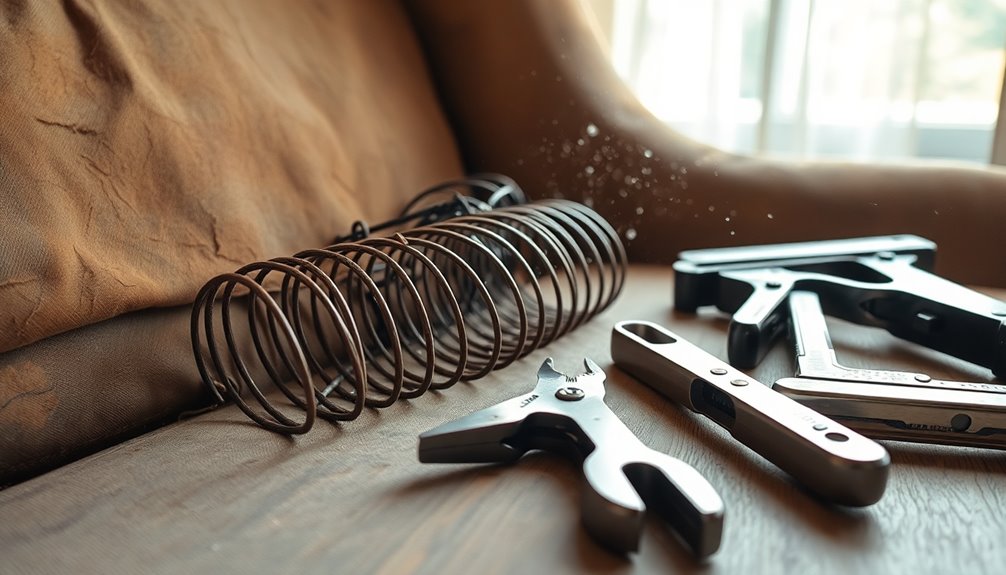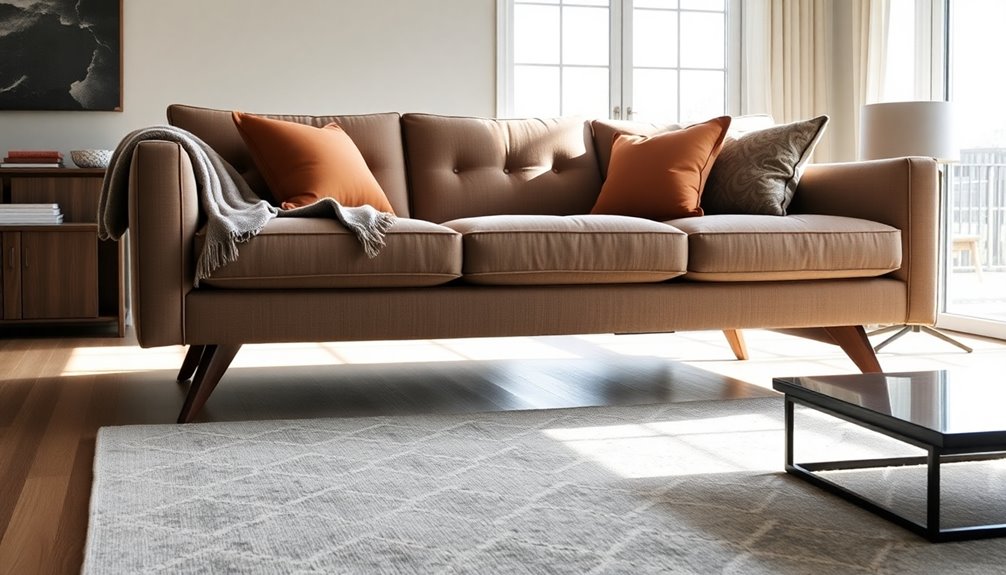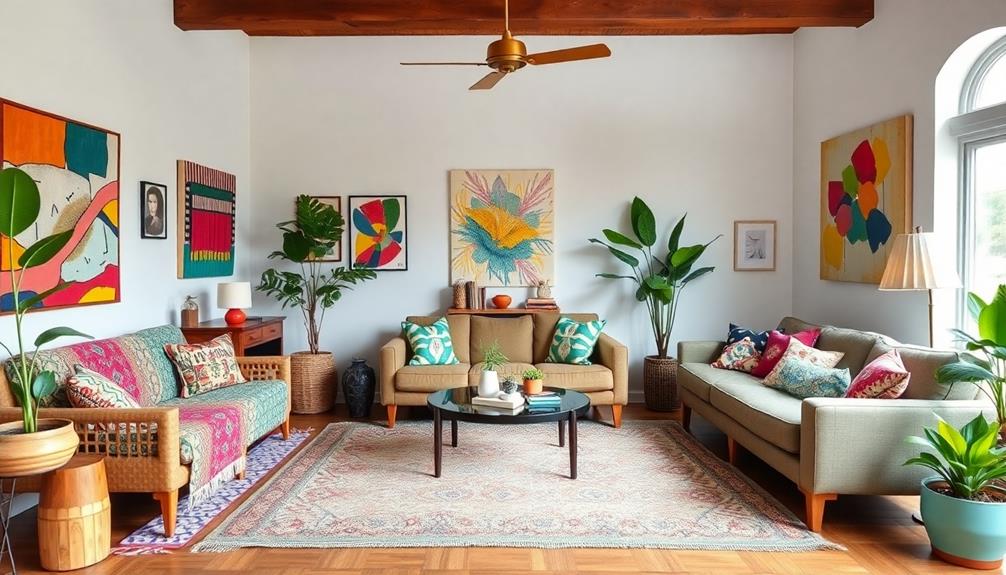Renaissance furniture captures the essence of a pivotal era, blending artistry and practicality. You'll notice the emphasis on symmetry, proportion, and rich materials like oak and mahogany, all designed for both beauty and function. Intricate carvings featuring classical motifs and luxurious fabrics like brocade elevate the visual appeal. Each piece, from ornate chairs to functional tables, tells a story of craftsmanship and cultural shifts. The styles vary regionally, reflecting local traditions and sensibilities, giving you a diverse experience of the period. Keep exploring, and you'll uncover even more fascinating layers of this artistic furniture style.
Key Takeaways
- Renaissance furniture showcased artistry, combining functionality with intricate designs that reflected the era's emphasis on craftsmanship and aesthetics.
- Rich materials like oak, walnut, and mahogany were commonly used, enhancing the durability and elegance of furniture pieces.
- Symmetry and proportion were key design principles, embodying the classical ideals that influenced Renaissance art and architecture.
- Regional styles varied significantly, with Italian furniture emphasizing bold artistry, while French designs focused on elegance and English styles prioritized functionality.
- The cultural impact of Renaissance furniture mirrored societal shifts, showcasing humanism, individualism, and the rise of the bourgeoisie through luxurious designs.
Historical Overview

As the Renaissance unfolded in Italy during the 14th century, it set the stage for a transformative period in furniture design that lasted into the 17th century.
This era marked a significant shift from the Middle Ages toward modernity, fueled by the revival of classical antiquity and humanism. You'll notice how the ideas of key figures like Leonardo da Vinci and Michelangelo shaped not just art, but also the very furniture that adorned homes.
As Renaissance principles spread throughout Europe, they influenced various art forms and architectural styles. This period emphasized the importance of artistry and craftsmanship, laying the groundwork for furniture that was both functional and aesthetically pleasing, reflecting the evolving tastes and values of society during this remarkable time.
Design Characteristics
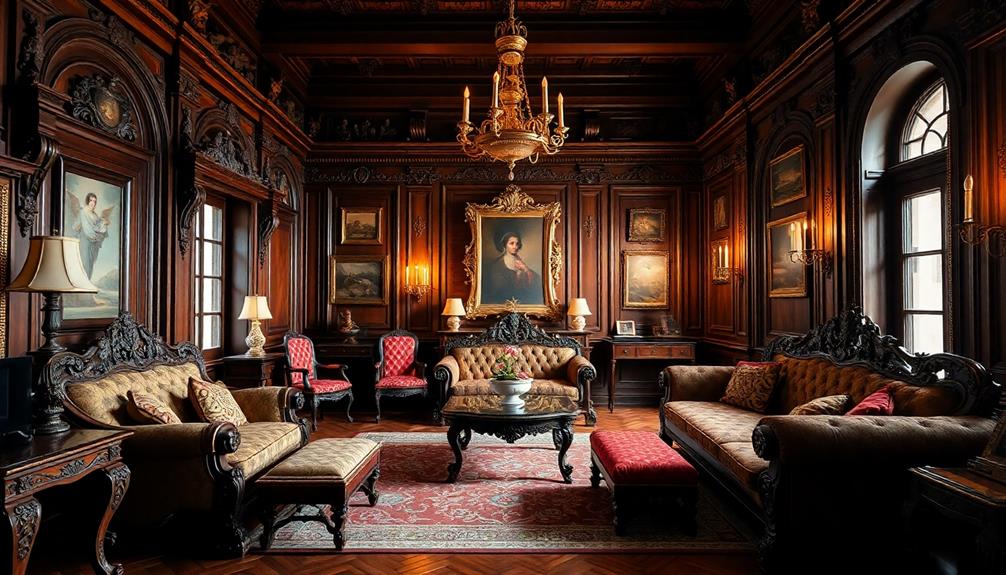
Renaissance furniture is characterized by its emphasis on symmetry and proportion, reflecting the era's artistic ideals.
You'll notice the use of rich materials like oak, walnut, and mahogany, which provide both durability and elegance.
Intricate carvings adorn many pieces, showcasing detailed ornamentation that often incorporates classical motifs such as columns and arches.
Bold colors and luxurious fabrics, including brocade and velvet, enhance the visual appeal.
As you explore this furniture style, you'll appreciate how each element contributes to a cohesive look that embodies the grandeur of the period.
The overall design invites you to experience a blend of artistry and functionality, making Renaissance furniture timeless and influential in the evolution of interior design.
Furniture Types
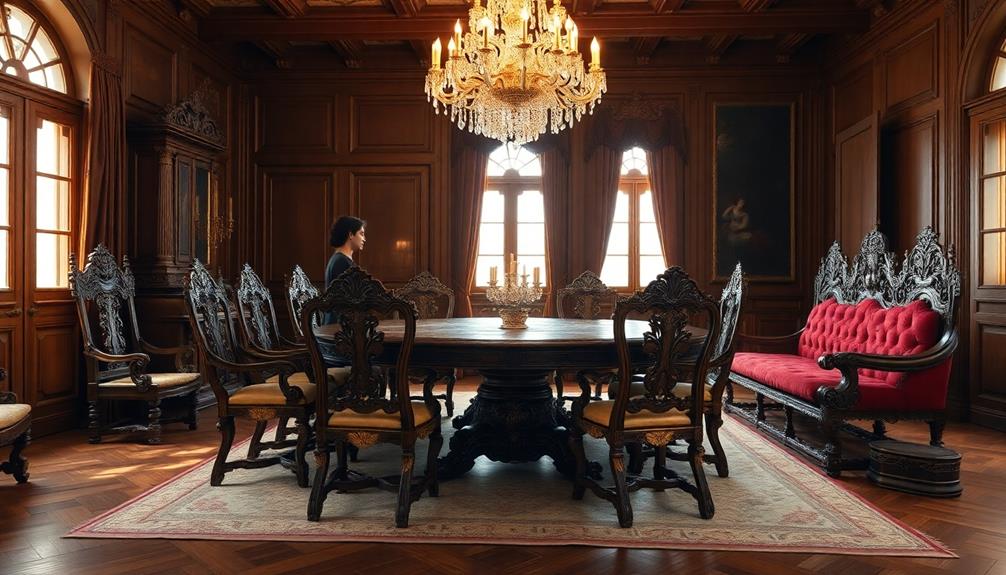
Explore the diverse types of furniture that define the Renaissance period, each piece crafted with intention and artistry.
You'll find tables that serve as both functional surfaces and statement pieces, often adorned with intricate carvings.
Chairs, particularly thrones and armchairs, showcase grandeur and comfort, reflecting the era's elegance.
Armoires combine storage with decorative flair, while credenzas elevate dining experiences with their elaborate designs.
Chests and trunks, essential for storage, often display artistic carvings that tell stories.
Finally, beds stand out with their canopies and ornate headboards, emphasizing luxury.
Each type of furniture not only serves a purpose but also embodies the spirit of the Renaissance, merging functionality with exceptional craftsmanship.
Regional Styles
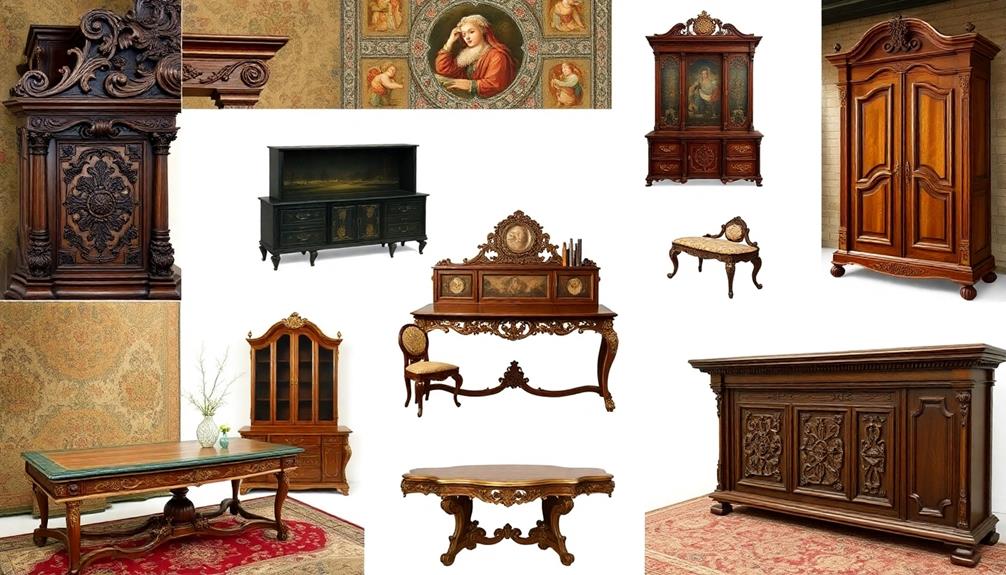
While the essence of Renaissance furniture is consistent across Europe, regional styles reveal distinct characteristics shaped by local culture and craftsmanship.
In Italy, you'll notice an emphasis on intricate artistry, showcasing bold carvings and elaborate designs that reflect the region's rich artistic heritage.
French styles lean towards elegance, often featuring refined shapes and luxurious materials.
On the other hand, English designs prioritize functionality, blending practicality with aesthetic appeal, while Spanish pieces frequently incorporate Moorish influences, adding a unique flair.
Dutch Renaissance furniture stands out for its simplicity and practicality, focusing on clean lines and utilitarian designs.
These regional variations not only highlight the diversity of Renaissance furniture but also offer insight into the values and tastes of each culture.
Cultural Impact
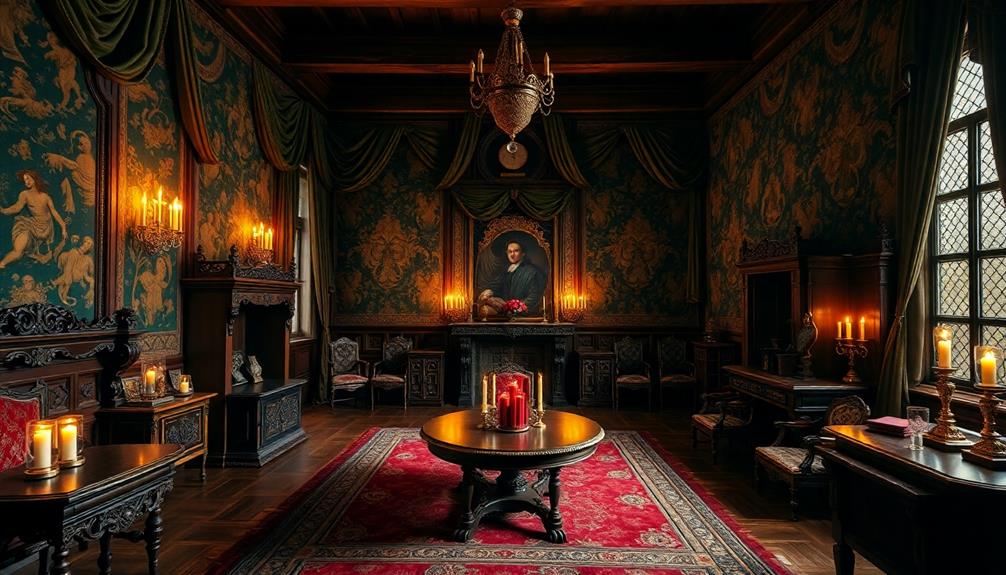
Furniture from the Renaissance era isn't just about aesthetics; it reflects the profound cultural shifts of the time. As you explore these pieces, you'll notice how they embody the values of humanism and individualism, emphasizing the importance of personal expression.
The intricate designs and religious motifs tell stories of faith and intellect, connecting you to a vibrant cultural landscape. You can see the influence of art and literature on furniture design, showcasing the creativity and craftsmanship of skilled artisans. The use of natural materials in Balinese interiors further emphasizes the connection to the environment and traditional practices. The rich textures and earthy tones create a sense of harmony and tranquility, inviting a deeper appreciation for the beauty of the natural world. The integration of sustainable materials also reflects a commitment to preserving the cultural heritage and supporting local communities.
Additionally, the rise of the bourgeoisie is evident in the luxurious materials and elaborate styles, signifying a shift in societal power.
Ultimately, Renaissance furniture serves as a tangible link to the transformative ideas and aspirations of its era.
Frequently Asked Questions
What Are the Best Ways to Care for Renaissance Furniture?
To care for Renaissance furniture, dust regularly with a soft cloth, avoid direct sunlight, and maintain humidity levels. Use gentle cleaners for surfaces and apply furniture polish sparingly to keep the wood nourished and protected.
How Can I Identify Authentic Renaissance Furniture Pieces?
You might think all old furniture's Renaissance, but check for intricate carvings, rich materials, and historical provenance. Authentic pieces whisper stories through their craftsmanship, while modern replicas can't compete with their timeless elegance and authenticity.
Are There Modern Reproductions of Renaissance Furniture?
Yes, you'll find modern reproductions of Renaissance furniture that mimic the style and craftsmanship. Many artisans create pieces using traditional techniques, so you can enjoy the elegance of that era in your own home.
What Is the Average Cost of Renaissance Furniture Today?
Ever wondered how much Renaissance furniture costs today? It typically ranges from a few hundred to several thousand dollars, depending on craftsmanship, materials, and rarity. You'll find unique pieces that truly enhance your space.
Where Can I Find Renaissance Furniture for Sale?
You can find Renaissance furniture for sale at antique shops, online marketplaces like Etsy or eBay, and specialized auction houses. Don't forget to check local estate sales or vintage fairs for unique pieces.
Conclusion
As you close the door on the Renaissance, you step into a domain where each piece of furniture tells a story, much like a wise old tree whispering secrets of the past. The elegance and craftsmanship you've explored serve as the roots of modern design, nurturing creativity and expression. Just as the Renaissance breathed life into art, these timeless pieces inspire you to embrace beauty and grace in your own everyday surroundings, echoing the spirit of an extraordinary era.
